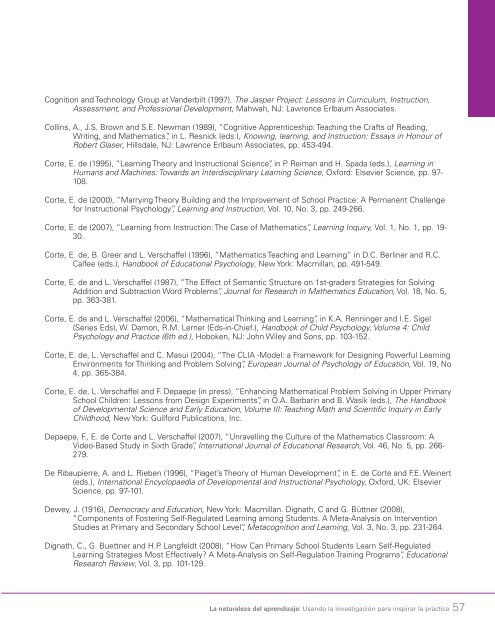del aprendizaje
2aGaJxc
2aGaJxc
You also want an ePaper? Increase the reach of your titles
YUMPU automatically turns print PDFs into web optimized ePapers that Google loves.
Cognition and Technology Group at Vanderbilt (1997), The Jasper Project: Lessons in Curriculum, Instruction,<br />
Assessment, and Professional Development, Mahwah, NJ: Lawrence Erlbaum Associates.<br />
Collins, A., J.S. Brown and S.E. Newman (1989), “Cognitive Apprenticeship: Teaching the Crafts of Reading,<br />
Writing, and Mathematics”, in L. Resnick (eds.), Knowing, learning, and Instruction: Essays in Honour of<br />
Robert Glaser, Hillsdale, NJ: Lawrence Erlbaum Associates, pp. 453-494.<br />
Corte, E. de (1995), “Learning Theory and Instructional Science”, in P. Reiman and H. Spada (eds.), Learning in<br />
Humans and Machines: Towards an Interdisciplinary Learning Science, Oxford: Elsevier Science, pp. 97-<br />
108.<br />
Corte, E. de (2000), “Marrying Theory Building and the Improvement of School Practice: A Permanent Challenge<br />
for Instructional Psychology”, Learning and Instruction, Vol. 10, No. 3, pp. 249-266.<br />
Corte, E. de (2007), “Learning from Instruction: The Case of Mathematics”, Learning Inquiry, Vol. 1, No. 1, pp. 19-<br />
30.<br />
Corte, E. de, B. Greer and L. Verschaffel (1996), “Mathematics Teaching and Learning” in D.C. Berliner and R.C.<br />
Calfee (eds.), Handbook of Educational Psychology, New York: Macmillan, pp. 491-549.<br />
Corte, E. de and L. Verschaffel (1987), “The Effect of Semantic Structure on 1st-graders Strategies for Solving<br />
Addition and Subtraction Word Problems”, Journal for Research in Mathematics Education, Vol. 18, No. 5,<br />
pp. 363-381.<br />
Corte, E. de and L. Verschaffel (2006), “Mathematical Thinking and Learning”, in K.A. Renninger and I.E. Sigel<br />
(Series Eds), W. Damon, R.M. Lerner (Eds-in-Chief.), Handbook of Child Psychology, Volume 4: Child<br />
Psychology and Practice (6th ed.), Hoboken, NJ: John Wiley and Sons, pp. 103-152.<br />
Corte, E. de, L. Verschaffel and C. Masui (2004), “The CLIA -Mo<strong>del</strong>: a Framework for Designing Powerful Learning<br />
Environments for Thinking and Problem Solving”, European Journal of Psychology of Education, Vol. 19, No<br />
4, pp. 365-384.<br />
Corte, E. de, L. Verschaffel and F. Depaepe (in press), “Enhancing Mathematical Problem Solving in Upper Primary<br />
School Children: Lessons from Design Experiments”, in O.A. Barbarin and B. Wasik (eds.), The Handbook<br />
of Developmental Science and Early Education, Volume III: Teaching Math and Scientific Inquiry in Early<br />
Childhood, New York: Guilford Publications, Inc.<br />
Depaepe, F., E. de Corte and L. Verschaffel (2007), “Unravelling the Culture of the Mathematics Classroom: A<br />
Video-Based Study in Sixth Grade”, International Journal of Educational Research, Vol. 46, No. 5, pp. 266-<br />
279.<br />
De Ribaupierre, A. and L. Rieben (1996), “Piaget’s Theory of Human Development”, in E. de Corte and F.E. Weinert<br />
(eds.), International Encyclopaedia of Developmental and Instructional Psychology, Oxford, UK: Elsevier<br />
Science, pp. 97-101.<br />
Dewey, J. (1916), Democracy and Education, New York: Macmillan. Dignath, C and G. Büttner (2008),<br />
“Components of Fostering Self-Regulated Learning among Students. A Meta-Analysis on Intervention<br />
Studies at Primary and Secondary School Level”, Metacognition and Learning, Vol. 3, No. 3, pp. 231-264.<br />
Dignath, C., G. Buettner and H.P. Langfeldt (2008), “How Can Primary School Students Learn Self-Regulated<br />
Learning Strategies Most Effectively? A Meta-Analysis on Self-Regulation Training Programs”, Educational<br />
Research Review, Vol. 3, pp. 101-129.<br />
La naturaleza <strong>del</strong> <strong>aprendizaje</strong>: Usando la investigación para inspirar la práctica 57


